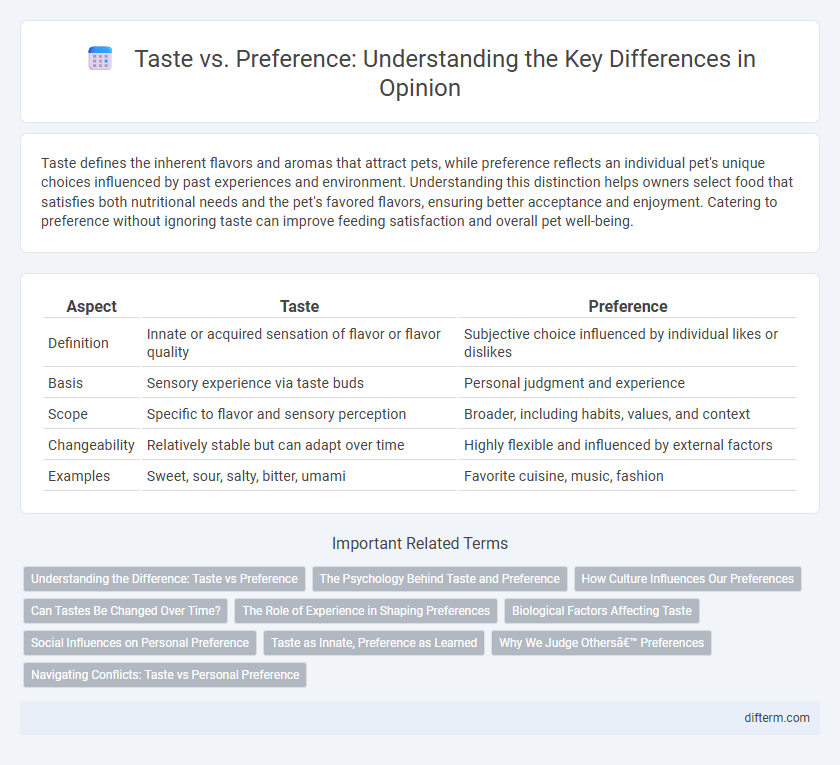Taste defines the inherent flavors and aromas that attract pets, while preference reflects an individual pet's unique choices influenced by past experiences and environment. Understanding this distinction helps owners select food that satisfies both nutritional needs and the pet's favored flavors, ensuring better acceptance and enjoyment. Catering to preference without ignoring taste can improve feeding satisfaction and overall pet well-being.
Table of Comparison
| Aspect | Taste | Preference |
|---|---|---|
| Definition | Innate or acquired sensation of flavor or flavor quality | Subjective choice influenced by individual likes or dislikes |
| Basis | Sensory experience via taste buds | Personal judgment and experience |
| Scope | Specific to flavor and sensory perception | Broader, including habits, values, and context |
| Changeability | Relatively stable but can adapt over time | Highly flexible and influenced by external factors |
| Examples | Sweet, sour, salty, bitter, umami | Favorite cuisine, music, fashion |
Understanding the Difference: Taste vs Preference
Taste refers to the innate sensory perception of flavors, influenced by biological factors such as genetics and taste buds, while preference encompasses the individual's subjective choice shaped by personal experiences, culture, and exposure. Recognizing that taste is a physiological response whereas preference is a psychological and social construct helps clarify discussions about food, art, and lifestyle choices. Understanding this distinction enhances communication about personal likes and dislikes, reducing misunderstandings in consumer behavior and interpersonal contexts.
The Psychology Behind Taste and Preference
Taste and preference stem from complex psychological processes involving sensory perception, memory, and cultural influences. Neural mechanisms in the brain interpret taste stimuli differently based on individual experiences, shaping unique preferences over time. Understanding these mental frameworks helps explain why people favor distinct flavors despite shared biological taste receptors.
How Culture Influences Our Preferences
Cultural background profoundly shapes taste preferences by exposing individuals to specific flavors, ingredients, and culinary traditions from an early age. These culturally ingrained tastes often dictate what people find appealing or off-putting, making preference a reflection of collective heritage rather than pure individual choice. Studies in food anthropology reveal that taste preferences evolve within cultural contexts, reinforcing social identity and community bonds.
Can Tastes Be Changed Over Time?
Tastes are shaped by biology and early exposure but can evolve through repeated experiences and cultural influences, highlighting the brain's plasticity in flavor perception. Preference reflects a deeper psychological and emotional attachment that adapts as individuals encounter new cuisines, dietary needs, or health considerations. Scientific studies confirm that gradual exposure to diverse flavors can rewire taste receptors and shift preferences, proving that taste development is dynamic rather than fixed.
The Role of Experience in Shaping Preferences
Experience plays a crucial role in shaping taste preferences by exposing individuals to diverse flavors that influence their acceptance and enjoyment. Repeated exposure to particular tastes, such as bitter vegetables or spicy foods, can gradually enhance preference through sensory adaptation and learned associations. Cultural background and personal history further interact with experience, reinforcing or altering taste preferences over time.
Biological Factors Affecting Taste
Biological factors such as genetics and age significantly influence taste perception, shaping individual preferences. Variations in taste receptor genes like TAS2R38 determine sensitivity to bitter compounds, affecting food choices. Age-related declines in taste bud function also alter flavor detection, leading to shifting preferences over time.
Social Influences on Personal Preference
Social influences profoundly shape personal preferences by shaping the environment where tastes are developed, such as family traditions, peer groups, and cultural norms. Exposure to diverse social settings can alter individual tastes by creating associations and expectations around specific flavors or styles. Understanding how social context molds preferences highlights the dynamic interplay between external factors and internal taste perception.
Taste as Innate, Preference as Learned
Taste is an innate sensory experience shaped by genetic makeup and biological factors, guiding immediate reactions to flavors such as bitterness or sweetness. Preference develops over time, influenced by cultural exposure, personal experiences, and social environment, reflecting learned behaviors rather than inherent responses. Understanding this distinction highlights how taste drives initial acceptance, while preference shapes long-term dietary choices and habits.
Why We Judge Others’ Preferences
Judging others' preferences often stems from cognitive biases and social conditioning that cause individuals to equate personal taste with universal standards. People tend to project their own values and experiences onto others, leading to misconceptions about different preferences. Understanding this behavior requires recognizing the underlying need for social validation and the discomfort with unfamiliar or contrasting choices.
Navigating Conflicts: Taste vs Personal Preference
Taste reflects an individual's inherent sensory response to flavors, while personal preference encompasses a broader range of influences including culture, experiences, and emotions. Navigating conflicts between taste and preference requires recognizing that what pleases one person's palate may not align with another's values or lifestyle choices. Resolving these differences involves open communication and respecting diverse perspectives to find common ground in shared experiences.
taste vs preference Infographic

 difterm.com
difterm.com